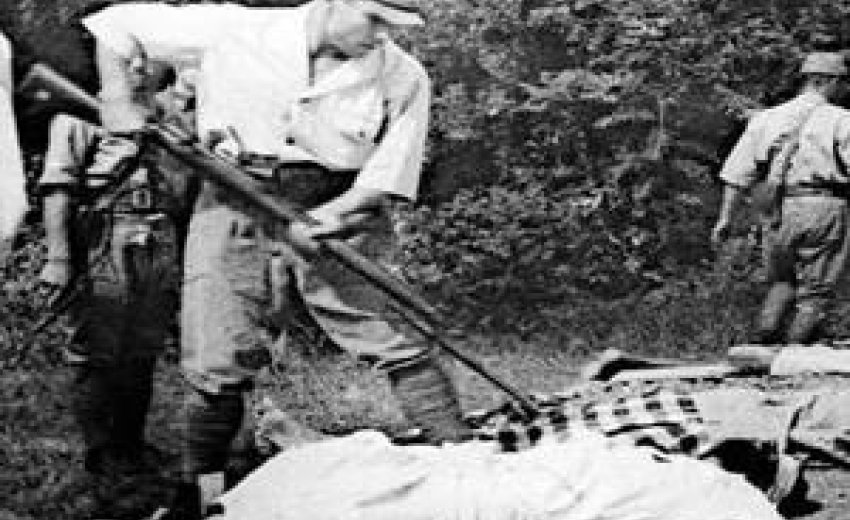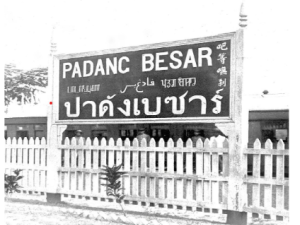| Sikh troops disembarking from ships into Malaya |
When the history of this titanic struggle comes to be written in mature perspective none of its many sides will, we believe, excite more wonderment and more ungrudging admiration than the part the Sikhs soldiers have played in it.
As of 7th December, 1941, the summary of strength of army in Malaya was 86,895 troops. Two third of the total force were Indian soldiers. Sikhs represented more than 60 percent of the total Indian force.
December 8th, 1941 at 12.15 am local time, Japanese 18th. Divisions troops hits the sandy beaches of Sabak-Badang Beach, Kota Bahru and at 4am (Tokyo Time) Japanese 5th Divisions forces splash ashore unopposed at Singora (now Songkhla) and Patani.
As the first disgorging invaders hit the junction of the Badang and Sabak beaches, they come under withering machine-gun fire from pillboxes manned by the 3/17th Dogra (Indian) Regiment. The invaders lose one third of their initial assault forces of 5,300 men in fearful beach fighting before annihilating the Indian defenders who die in their pillbox positions, refusing neither to withdraw nor to surrender.
An armoured train, with 30 men from the 2/16th Panjab Regiment and some engineers, advancing into Thailand from Padang Besar in Perlis reached Khlong Ngae, in southern Thailand, and successfully destroyed a 200 foot bridge before withdrawing back to Padang Besar.
On 22nd December, 3/2nd Panjab Regiment engineered an ambush on the Japanese at Grik Road, Perak which results heavy casualties on the invaders. The regiment fought fierce delaying actions against the Imperial Guards.
On December 30th, 1941 to 2nd January, 1942, a battle between 3000 British personnel and over 6000 Japanese soldiers erupted. The 11th Indian Division managed to delay the Japanese advance at Kampar for a few days, in which the Japanese suffered severe casualties in terrain that did not allow them to use their tanks or their air superiority to defeat the British. A Sikh company of the 1/8th Panjab Regiment throws back a furious attack with a classic bayonet charge through massive mortar and machine- gun fire. Only 30 members of the company survive the action but the position holds. The Japanese lost more then 500 men here and Japanese commanders, for the first time in the war, consider retreating.
| Sikh Gunners in a rubber plantation in Sahum, Kampar Perak |
On 30th January, 1942, a Sikh Battalion made an ambush on a strong Japanese party north of Kluang, Johor. The Japanese squealed with absolute panic when charged with bayonets. Sikhs captured 250 motor cycles and 150 bicycles when they charged the Japanese positions and machine-gun post. Further details of the attack made by the Sikh Battalion North of Kluang reveals that the enemy casualties numbered at least 400, 2 small field guns and many mortars which was tied on their bicycles and tommy-guns were also destroyed.
During the Battle of Muar, members of both the Australian 8th Division and the 45th Indian Infantry Brigade were making a fighting withdrawal when they became surrounded near the bridge at Parit Sulong. The Allies fought the larger Japanese forces for two days until they ran low on ammunition and food. Able-bodied soldiers were ordered to disperse into the lush jungle, the only way they could return to Allied lines.
The wounded prisoners of war were kicked and beaten with rifle butts by the Imperial Guards. At least some were tied up with wire in the middle of the road, machine-gunned, had petrol poured over them, were set alight and were "after their incineration - were systematically run over, back and forwards, by Japanese driven trucks." Anecdotal accounts by local people also reported POWs being tied together with wire and forced to stand on a bridge, before a Japanese soldier shot one, causing the rest to fall into the Simpang Kiri River and drown. 110 Australians and 35 Indians are massacred by the Japanese. In the face of death, the Sikh prisoners sat with dignity.
| This photograph was found among Japanese records, when British troops re-entered Singapore. This picture shows the inhumane brutality practiced by the Japanese on Sikh prisoners. |
History speaks for itself on the valour, bravery displayed by the Sikhs. The never-say-die spirit of the Sikhs gave us the impetus and inner strength and resilience to face any challenges that came our way. Sikh soldiers adhered to the faith and never flinched nor surrendered in the face of adversity.
It is recommended that the reader have a geographical knowledge of the location of Peninsular Malaysia, to be able to envisage where the above incidents unfolded. The pictures reveal the genuine expression of the bravery, dedication and the unity of the Sikhs exemplified by the Sikhs in battlefields and evidently, they faced any challenge without any fear or trepidation.






